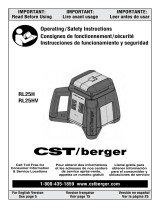
5.2 General safety rules
a) Do not render safety devices ineffective and do
not remove information and warning notices.
b) Stay alert, watch what you are doing and use
common sense when operating the tool. Don’t
use the tool when you are tired or under the influ-
ence of drugs, alcohol or medication. Amomentof
inattention while operating tools may result in serious
personal injury.
c) Keep laser tools out of reach of children.
d) Failure to follow the correct procedures when open-
ing the tool may cause emission of laser radiation
in excess of Class 3R / Class IIIa. Have the tool
repaired only at a Hilti service center.
e) Do not operate the tool in explosive atmospheres,
such as in the presence of flammable liquids,
gases or dust. Tools and appliances create sparks
which may ignite the dust or fumes.
f) (Statement in accordance with FCC §15.21):
Changes or modifications not expressly approved
by the manufacturer can void the user’s authority to
operate the equipment.
g) Use of setting-up / adjusting devices and equipment
or operating procedures other than those specified in
these instructions may lead to exposure to hazardous
radiation.
h) Check the condition of the tool before use. If the
tool is found to be damaged, have it repaired at a
Hilti service center.
i) The user must check the accuracy of the tool
after it has been dropped or subjected to other
mechanical stresses.
j) When the tool is brought into a warm environment
from very cold conditions, or vice-versa, allow it
to become acclimatized before use.
k) Maintain the tool carefully. Check for misalign-
ment or binding of moving parts, breakage of
parts and any other condition that may affect the
tool’s operation. If damaged, have the tool re-
paired before use. Poor maintenance is the cause
of many accidents.
l) Make sure that the tool is mounted securely when
adapters or accessories are used.
m) Keep the laser exit aperture clean to avoid meas-
urement errors.
n) Although the tool is designed for the tough condi-
tions of jobsite use, as with other optical and elec-
tronic instruments (e.g. binoculars, spectacles,
cameras) it should be treated with care.
o) Although the tool is protected to prevent entry
of dampness, it should be wiped dry each time
before being put away in its transport container.
p) Keep the electrical contacts dry (protect from rain
or dampness).
q) Check the tool before using it for important meas-
uring work.
r) Check the accuracy of the measurements several
times during use of the tool.
s) Use the AC adapter only for connecting to the AC
supply.
t) Check to ensure that the tool and AC adapter do
not present an obstacle that could lead to a risk
of tripping and personal injury.
u) Ensure that the workplace is well lit.
v) Check the condition of the extension cord and
replace it if damage is found. Do not touch the AC
adapter if the extension cord or AC adapter are
damaged while working. Disconnect the supply
cord plug from the power outlet. Damaged supply
cords or extension cords present a risk of electric
shock.
w) Avoid body contact with earthed or grounded
surfaces, such as pipes, radiators, ranges and
refrigerators. There is an increased risk of electric
shock if your body is earthed or grounded.
x) Do not expose the supply cord to heat, oil or sharp
edges.
y) Never operate the AC adapter when it is dirty or
wet. Dust (especially dust from conductive ma-
terials) or dampness adhering to the surface of
the AC adapter may, under unfavorable condi-
tions, lead to electric shock. Dirty or dusty tools
should thus be checked at a Hilti Service Center
at regular intervals, especially if used frequently
for working on conductive materials.
z) Avoid touching the contacts.
5.2.1 Battery tool use and care
a) Do not expose batteries to high temperatures and
keep them away from fire. This presents a risk of
explosion.
b) Do not disassemble, squash or incinerate batter-
ies and do not subject them to temperatures over
75°C. This presents a risk of fire, explosion or injury
through contact with caustic substances.
c) Use only the rechargeable battery and batteries
specified for use with the tool. Use of other re-
chargeable batteries or unspecified batteries may
result in injury and present a risk of fire.
d) Avoid ingress of moisture. Moisture in the interior
of the tool may cause a short circuit and chemical
reactions resulting in burns to the skin or fire.
e) Under abusive conditions, liquid may leak from the
battery. Avoid contact. If contact accidentally oc-
curs, flush with water. In the event of the liquid
coming into contact with the eyes, rinse the eyes
with plenty of water and consult a doctor. Liquid
ejected from the battery may cause irritation or burns.
f) Use only batteries of the type approved for use
with the applicable tool. Use of other batteries or
use of the batteries for purposes for which they are
not intended presents a risk of fire and explosion.
g) Observe the special guidelines applicable to the
transport, storage and use of Li-ion batteries.
h) Paper clips, coins, keys, nails, screws and other
small metal objects that could short-circuit the
en
23
Printed: 11.04.2016 | Doc-Nr: PUB / 5162039 / 000 / 02





















